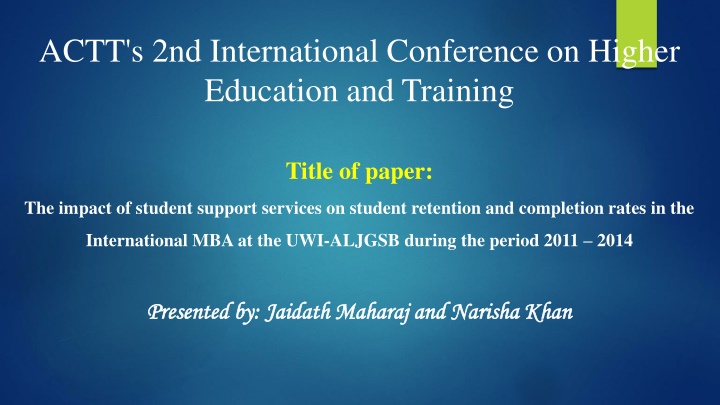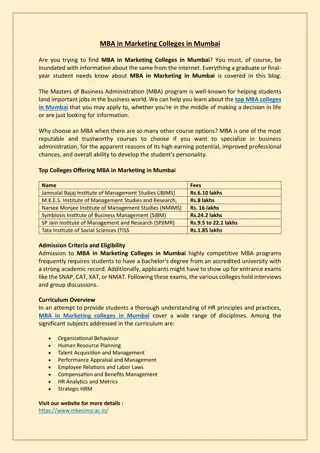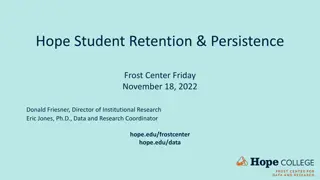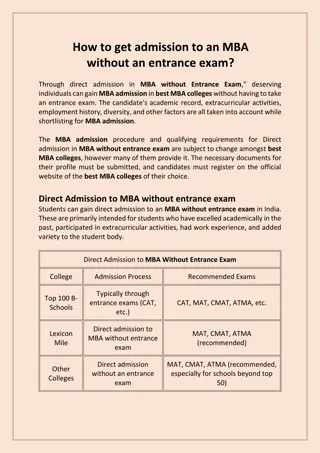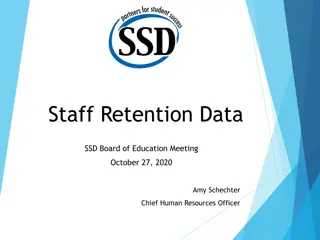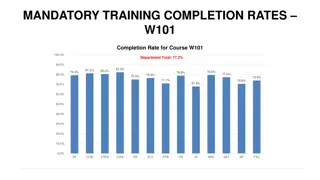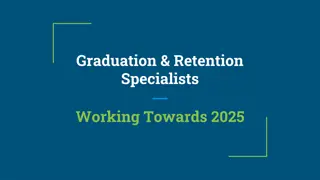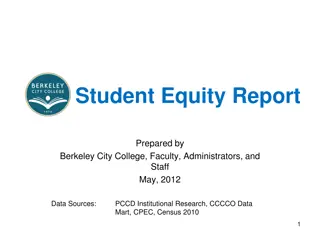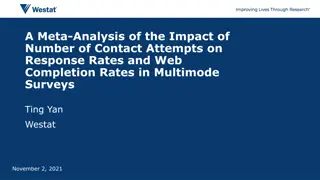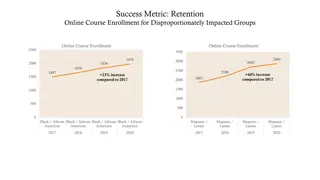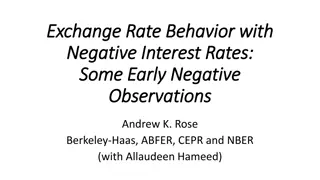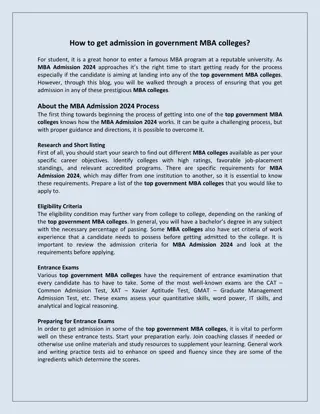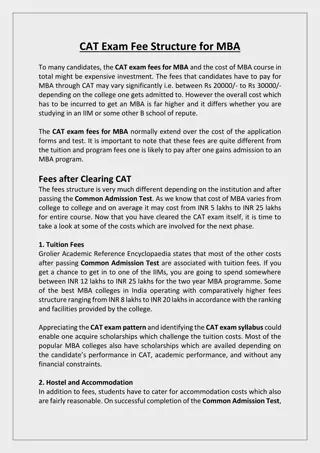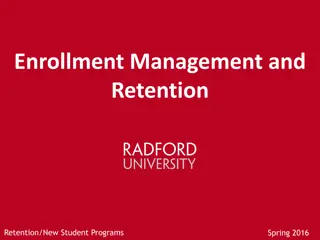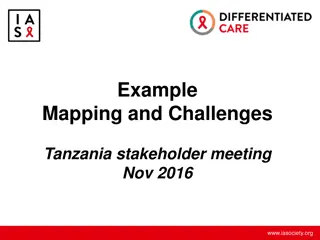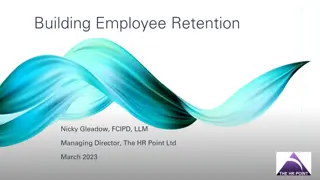Impact of Student Support Services on MBA Student Retention & Completion Rates
This study explores the influence of student support services on retention and completion rates in the International MBA program at UWI-ALJGSB. The research delves into the implications of services provided within the program from 2011 to 2014.
Download Presentation

Please find below an Image/Link to download the presentation.
The content on the website is provided AS IS for your information and personal use only. It may not be sold, licensed, or shared on other websites without obtaining consent from the author.If you encounter any issues during the download, it is possible that the publisher has removed the file from their server.
You are allowed to download the files provided on this website for personal or commercial use, subject to the condition that they are used lawfully. All files are the property of their respective owners.
The content on the website is provided AS IS for your information and personal use only. It may not be sold, licensed, or shared on other websites without obtaining consent from the author.
E N D
Presentation Transcript
ACTT's 2nd International Conference on Higher Education and Training Title of paper: The impact of student support services on student retention and completion rates in the International MBA at the UWI-ALJGSB during the period 2011 2014 Presented by: Jaidath Maharaj and Narisha Khan Presented by: Jaidath Maharaj and Narisha Khan
Review of Literature: Overall student support services positively impacted retention rates and completion rates Study by Paul Smiths College showed that every $100 USD spent on student support led to a .06% increase in graduation rates Study commissioned by the New Zealand Ministry of Education showed that student completion and retention rates are positively impacted through the following: Clear goals and student support processes Supplemental instructions (SI)
UWI-ALJGSB Student Support Services increased in response to the following-: AMBA accreditation exercise where it was seen that students were taking longer than required to complete the programmes (IMBA Completion rates was an average of 4 years for a 2 year programme) Attrition rates were increasing Mandate by the UWI to have students complete the programmes or face permanent withdrawals from their programmes.
Focus of the study was the IMBA because of the following-: Number of students within the programme Highest attrition rate Highest number of students with course failure and incomplete practicum Therefore it presented the greatest opportunity for the impact of interventions to be measured
Total Number of Students by Programme from January 2012 to January 2015 23 Master in Port and Maritime Management 54 MBA Sustainable Energy Management 36 MBA International Trade and Logistics Mnaagement 20 Master Information Systems & Technology Management 66 International Master of Business Development & Innovation 157 Master of Small, Medium and Enterprise Management 94 MSc in International Finance 100 Master of Marketing 85 Masters in Human Resource Management 100 Executive MBA 235 International MBA 0 50 100 150 200 250 Total Number of Students
Why need for students to complete the programmes? Reputation of the institution - critical in a highly competitive market According to Abdullah (2006), higher education is being driven towards commercial competition imposed by economic forces resulting from the development of global education markets and the reduction of government funds
Globally this issue of student dissatisfaction in higher education has become an issue of great importance given that it is the fastest growing service industry in the globe according to Hussain (2001). Hussain (2001) states that institutions of higher education need appropriate methods and strategies to meet the current students needs, keep them happy and attract more recruitment
Why need for students to complete the programmes? Contribution of the graduate of the school to the wider societal context Mission of the institution: To improve the international competitiveness of people and organisations in the Caribbean through business education, training, consulting and research .
Testimonials I would like to highly recommend the graduates of Lok Jack GSB to any organization which seeks to hire professional candidates to add value to their organization . I have observed a noticeable difference between GSB graduates and those from other schools. A GSB graduate is able to articulate and assess and analyse gaps, while developing solutions GSB graduates also can display critical thinking and an understanding of business practices. This may be why graduates can then easily move up within an organization having these essential business skills and knowledge.
Findings The table below shows the completion rates as at October 2013. It includes the students who were . scheduled to graduate having started the programmes in 2011 Intake Period Cohort Number Number in Cohort Number completed Number incomplete Completion Rate Jan 2011 36 23 11 14 44% Jan 2011 37 23 7 17 29% Sep 2011 38 18 2 18 10% Sep 2011 39 24 0 21 0% Sep 2011 40 8 0 7 0% Sep 2011 41 13 0 12 0%
The institution analysed the records of each student to determine the reasons for the non-completion of students. The following categories were identified-: Practicum outstanding Courses and practicum outstanding The findings of the data analysis is presented in the chart below-: Reasons for Non Completion of programmes by Cohort 3 6 6 41 4 0 5 40 13 6 4 39 11 6 3 38 8 8 2 37 5 9 1 36 0 5 10 15 20 25 30 35 40 45 Practicum & Courses Practicum Cohort
Having now understood the reasons for the non-completion of the programme by the students, the institution sought deeper insights into the factors that mitigated against the completion of the courses and the practicum. An instrument was developed and administered all student who should be engaging the practicum to understand the reasons for the non-completion of the practicum by students. 183 students responded to the survey distributed amongst the programmes as follows.
The pie chart shows that 44% of the students who have not completed the practicum belongs to the IMBA programme. The results of the students surveyed under the IMBA were collated and the responses were clustered into categories as follows-: Personal reasons Work related reasons Practicum administrative reasons Team issues Data collection issues
The quantitative courses had the highest failure rates and accounted for non-completion of the programmes by students. Amongst the quantitative courses, Introduction to Economics was targeted because of the high failure rates. The table below shows the pass rates for Introduction to Economics during the period 2011 2012
Practicum Intervention Identification of the students at greatest risk - 20 students identified Workshops business planning workshops and research methods workshops. Allowed for the sharing of practicum process information and answering of questions Practicum Presentations sessions allowed for students to share their progress and gain valuable feed back from peers and facilitators. They also would share their upcoming practicum tasks Identification of participating companies - the practicum units identified projects for teams. To date twenty (20) projects have been identified Formation of teams students were assisted in finding team members where needed Employers and alumni engagement alumni shared the experiences of the practicum and the value of the exercise to their personal development and the development of their companies and careers
Course Interventions: Introduction to Economics Tutorials six (6) tutorials, self guided study and online quizzes Course redesign greater focus on business elements Pedagogical shift to greater authenticity in teaching and learning greater interaction (started the class with 30 minutes of discussion of application questions. Course work changed to an application project and course is linked to OB and marketing. A major debate is used as the a course capstone activity Remedial mathematics two (2) mathematics tutorials are offered to students who demonstrate a need for such at the end of a mathematics diagnostics test is administered Use of teaching technology videos are used along with weblogs where the topics covered in the sessions are discussed in the context of the work environment
Post intervention findings The findings after the course interventions showed that a change in the figures for students success. The failure rate for Introduction to Economics dropped from 43% in 2012 to 20% in 2014.
Considering the IMBA practicum eligible students targeted of ninety eight (98), forty eight (48) students (49%) submitted proposals to date. The full effect of the intervention cannot as yet be measured since the students who have received the interventions are not as yet due to graduate. The initial surveys and interviews however have shown that students are much more positive about the process and are engaged given the proactive approach of the school. The institution was able to secure twenty two (22) projects for students which allowed for teams without a topic to begin their practicum.
Conclusion: Observed change in performance after intervention Next phase of the research will be to apply statistical processes to determine correlation and causation factors
